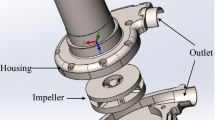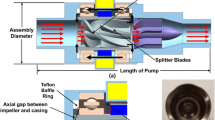Abstract
We have developed a hydrodynamically levitated centrifugal blood pump. In the blood pump having hydrodynamic bearings, the narrow bearing gap has a potential for high hemolysis. The purpose of the this study is to improve hemolysis performance in a hydrodynamically levitated centrifugal blood pump by optimizing a shroud size. The impeller was levitated passively at the position where the thrust forces acting on the impeller were balanced. We focused on a size of a bottom shroud with a hydrodynamic bearing that could change the bottom hydrodynamic force to balance the thrust force at the wide bearing gap for reducing hemolysis. Five test models with various shroud size were compared: 989 mm2 (HH-10.5), 962 mm2 (HH-12), 932 mm2 (HH-13.5), 874 mm2 (HH-16), and 821 mm2 (HH-18). A numerical analysis was first performed to estimate the bearing gaps in the test model. The bearing gaps were then measured to validate the numerical analysis. Finally, an in vitro hemolysis test was performed. The numerical analysis revealed that the HH-13.5 model had the widest bearing gap of 129 µm. In the measurement test, the estimation error for the bearing gap was less than 10%. In the hemolysis test, the HH-13.5 model achieved the lowest hemolysis level among the five models. The present study demonstrated that the numerical analysis was found to be effective for determining the optimal should size, and the HH-13.5 model had the optimal shroud size in the developed hydrodynamically levitated centrifugal blood pump to reduce hemolysis.






Similar content being viewed by others
References
Aaronson KD, Eppinger MJ, Dyke DB, Wright S, Pagani FD. Left ventricular assist device therapy improves utilization of donor hearts. J Am Coll Cardiol. 2002;39:1247–54.
Holley CT, Harvey L, John R. Left ventricular assist devices as a bridge to cardiac transplantation. J Thorac Dis. 2014;6:1110–9.
Pagani FD. Continuous-flow rotary left ventricular assist devices with “3rd generation” design. Semin Thorac Cardiovasc Surg. 2008;20:255–63.
Kirklin JK, Xie R, Cowger J, et al. Second annual report from the ISHLT mechanically assisted circulatory support registry. J Heart Lung Transplant. 2018;37:685–91.
Combes A. Mechanical circulatory support for end-stage heart failure. Metabolism. 2017;69S:S30–5.
Takayama H, Soni L, Kalesan B, Truby LK, Ota T, et al. Bridge-to-decision therapy with a continuous-flow external ventricular assist device in refractory cardiogenic shock of various causes. Circ Heart Fail. 2014;7:799–806.
Nisha AG, Gerin RS. Temporary mechanical circulatory support: a review of the options, indications, and outcomes. Clin Med Insights Cardiol. 2014;8:75–85.
Kosaka R, Nishida M, Maruyama O, Yambe T, Imachi K, Yamane T. Effect of a bearing gap on hemolytic property in a hydrodynamically levitated centrifugal blood pump with a semi-open impeller. Biomed Mater Eng. 2013;23:37–47.
Kosaka R, Maruyama O, Nishida M, Yada T, Saito S, Hirai S, Yamane T. Improvement of hemocompatibility in centrifugal blood pump with hydrodynamic bearings and semi-open impeller: in vitro evaluation. Artif Organs. 2009;33:798–804.
Kosaka R, Yada T, Nishida M, Maruyama O, Yamane T. Geometric optimization of a step bearing for a hydrodynamically levitated centrifugal blood pump for the reduction of hemolysis. Artif Organs. 2013;37:778–85.
Hori Y. Hydrodynamic lubrication. Tokyo, Japan: Springer; 2006.
Yamane T, Maruyama O, Nishida M, Kosaka R, Sugiyama D, et al. Hemocompatibility of a hydrodynamic levitation centrifugal blood pump. J Artif Organs. 2007;10:71–6.
Leverett LB, Hellums JD, Alfrey CP, Lynch EC. Red blood cell damage by shear stress. Biophys J. 1972;12:257–73.
Kataoka H, Kimura Y, Fujita H, Takatani S. Influence of radial clearance and rotor motion to hemolysis in a journal bearing of a centrifugal blood pump. Artif Organs. 2006;30:841–54.
Nishida M, Yamane T, Tsukamoto Y, Ito K, Konishi Y, Masuzawa T, Tsukiya T, Endo S, Taenaka Y. Shear evaluation by quantitative flow visualization near the casing surface of a centrifugal blood pump. JSME Int J Ser C. 2002;45:981–8.
Acknowledgments
This work was supported by JSPS KAKENHI Grant Numbers JP15K01305 and JP18K12049.
Author information
Authors and Affiliations
Corresponding author
Ethics declarations
Conflict of interest
The authors declare that they have no conflict of interest.
Additional information
Publisher's Note
Springer Nature remains neutral with regard to jurisdictional claims in published maps and institutional affiliations.
Rights and permissions
About this article
Cite this article
Kosaka, R., Sakota, D., Nishida, M. et al. Improvement of hemolysis performance in a hydrodynamically levitated centrifugal blood pump by optimizing a shroud size. J Artif Organs 24, 157–163 (2021). https://doi.org/10.1007/s10047-020-01240-6
Received:
Accepted:
Published:
Issue Date:
DOI: https://doi.org/10.1007/s10047-020-01240-6




